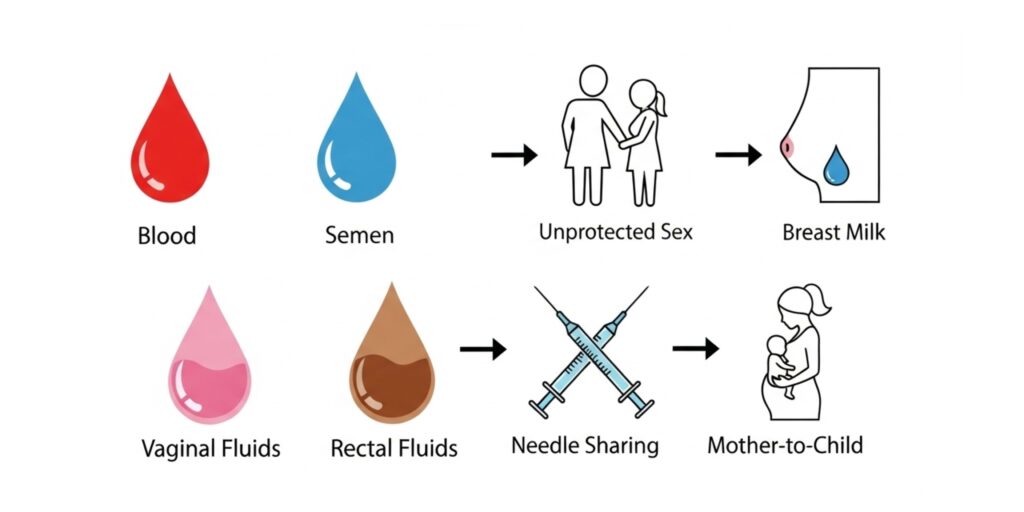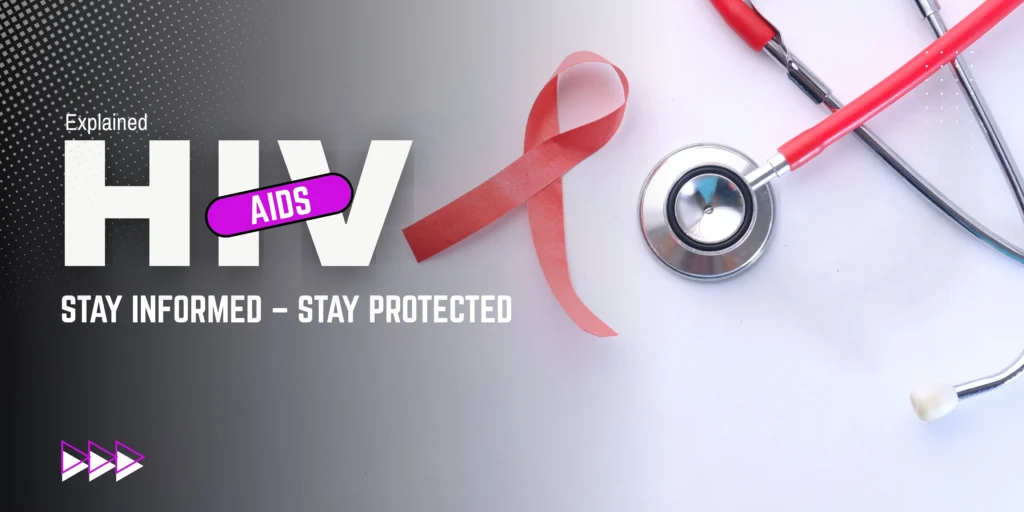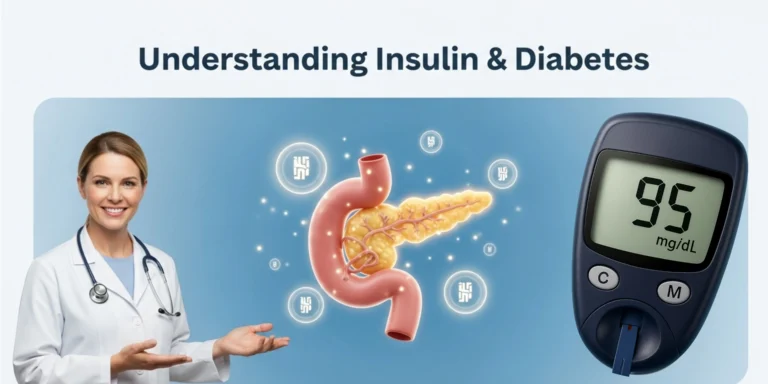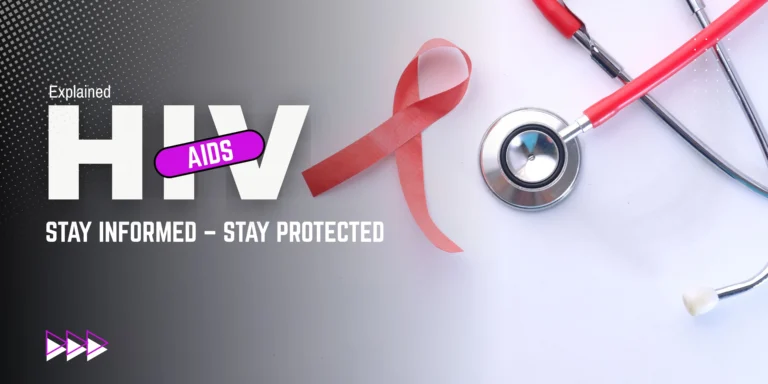There’s a lot of misinformation out there about HIV and AIDS, and it’s easy to get confused. Are they the same thing? How are they spread? What are the real risks? This post is designed to answer these questions with clear, accurate information so you can protect yourself and those you care about.
Are HIV and AIDS the Same? Not Exactly, But They’re Closely Connected
This is one of the most common points of confusion. To put it simply: HIV is a virus, and AIDS is a condition that can develop from the virus.
- HIV stands for Human Immunodeficiency Virus. It’s a virus that attacks your body’s immune system, specifically a type of white blood cell called CD4 cells. These cells are crucial for fighting off infections. Without treatment, HIV progressively weakens the immune system.
- AIDS stands for acquired immunodeficiency syndrome. This is the most advanced stage of an HIV infection. A person is diagnosed with AIDS when their immune system is severely damaged by HIV, making them vulnerable to a variety of opportunistic infections and specific cancers. An AIDS diagnosis is based on a low CD4 count (below 200 cells per cubic millimeter of blood) or the presence of one or more of these infections.
Think of it this way: contracting HIV is like a car getting a flat tire. The car is still running, but it’s damaged. If you don’t fix the flat tire and keep driving on it, the entire wheel and axle will eventually break down, causing the car to stop. In this analogy, the broken axle is AIDS—the most severe consequence of not addressing the initial problem (the HIV virus).
With modern medicine, people who are HIV-positive can live long, healthy lives and may never develop AIDS. Early diagnosis and consistent treatment are key to managing the virus and preventing it from progressing.
How HIV Is Transmitted
It’s crucial to understand exactly how HIV is spread to avoid it. HIV is transmitted through the exchange of specific bodily fluids from an infected person to a healthy person. These fluids include:
- Blood
- Semen (including pre-seminal fluid)
- Vaginal fluids
- Rectal fluids
- Breast milk
The most common ways HIV is transmitted are:
- Unprotected Sexual Contact: This is the primary way HIV is spread. It can happen during anal, vaginal, or oral sex without a condom. The virus can enter the body through the lining of the rectum, vagina, penis, or mouth, especially if there are cuts, sores, or tears. Using condoms correctly every time is an extremely effective way to prevent transmission.
- Sharing Needles: Sharing needles, syringes, or other drug injection equipment is a high-risk activity. Even tiny amounts of blood on a needle can carry enough of the virus to infect another person. This risk applies to both illegal drug use and sharing needles for things like tattoos or piercings if the equipment isn’t properly sterilized.
- Mother-to-Child Transmission: An HIV-positive mother can transmit the virus to her child during pregnancy, childbirth, or through breastfeeding. However, with proper medical care and medication, the risk of transmission can be reduced to less than 1%.
- Blood Transfusions (Extremely Rare in the U.S.): Today, all donated blood in the U.S. is screened for HIV, making transmission through blood transfusions very rare. This was a significant risk in the past, but with current safety protocols, it is no longer a major concern.
- Needle-stick Injuries (Healthcare Settings): While rare, a healthcare worker can be exposed to HIV if they are accidentally pricked with a needle used on an HIV-positive patient. Standard safety precautions and post-exposure prophylaxis (PEP) medication have significantly reduced this risk.
How HIV Is NOT Transmitted
Just as important as knowing how HIV is transmitted is knowing how it isn’t. HIV is not an “airborne” or “casual contact” virus. You cannot get HIV from:

- Hugging or shaking hands.
- Sharing toilets, towels, or bedding.
- Kissing (closed-mouth kissing). Deep, open-mouth kissing, while a very low risk, could potentially transmit HIV if both people have open sores or bleeding gums.
- Coughing or sneezing.
- Sharing food or drinks.
- Insects like mosquitoes or ticks.
- Using the same eating utensils.
- Sharing razors, toothbrushes, or other personal items (although sharing these is generally not recommended for hygiene reasons, the risk of HIV transmission is very low).
Because HIV is not spread through casual contact, it is completely safe to live with, work with, or be friends with someone who is HIV-positive. There is no risk of transmission from simply being in the same room, sharing a bed, or using the same utensils or bathroom.
Staying Safe: Prevention is Key
The best way to protect yourself is through prevention. The most effective strategies are:
- Practice Safe Sex: Use a condom every time you have sex. This is the most crucial step you can take. If you have multiple partners, the risk of exposure increases, so consistent and correct condom use is even more vital.
- Get Tested: Knowing your HIV status is the first step toward protecting yourself and others. If you test positive, you can begin treatment immediately, which can make the virus virtually undetectable and untransmittable. If you are negative, you can take steps to stay that way.
- Avoid Sharing Needles: Never share needles for injecting drugs, tattoos, or piercings.
- Consider PrEP: PrEP (Pre-Exposure Prophylaxis) is a daily pill that can significantly reduce the risk of getting HIV. It’s an excellent option for people who are HIV-negative but have a partner with HIV or are at higher risk of exposure.
Thanks to modern medicine, an HIV diagnosis is no longer a death sentence. People with HIV can live long, healthy lives. However, prevention is still the best strategy. By staying informed and taking simple precautions, you can protect yourself and help stop the spread of HIV.
Frequently Asked Questions about HIV and AIDS
Here are some of the most common questions people ask about HIV and AIDS.
1. What is the difference between HIV and AIDS?
HIV (Human Immunodeficiency Virus) is a virus that attacks your immune system. AIDS (Acquired Immunodeficiency Syndrome) is the most advanced stage of an HIV infection, diagnosed when the immune system is severely damaged. Not everyone with HIV will develop AIDS, especially with proper treatment.
2. How long does it take for HIV to turn into AIDS?
Without treatment, it can take anywhere from 10 to 15 years for HIV to progress to AIDS. However, this timeline can vary significantly from person to person. With proper medical care, many people with HIV never develop AIDS.
3. What are the first signs or symptoms of an HIV infection?
Many people experience no symptoms after initial infection. Others may have flu-like symptoms within two to four weeks, such as fever, rash, sore throat, and swollen lymph nodes. These symptoms are often mistaken for a common cold or the flu.
4. How is HIV transmitted?
HIV is transmitted through specific bodily fluids: blood, semen, vaginal fluids, rectal fluids, and breast milk. The most common ways are through unprotected sex and sharing needles.
5. Can you get HIV from oral sex?
Yes, though the risk is lower than with anal or vaginal sex. The risk increases if there are mouth sores, bleeding gums, or genital sores.
6. Is it safe to have sex with an HIV-positive person?
Yes, if the HIV-positive person is on effective treatment and has an “undetectable viral load,” they cannot sexually transmit HIV. This is known as “U=U” (Undetectable = Untransmittable). Consistent and correct condom use is also a highly effective method of prevention.
7. Can HIV be transmitted through kissing?
Casual kissing (closed-mouth) carries no risk of transmission. Deep, open-mouth kissing has a very low risk, but could potentially transmit the virus if both people have open sores or bleeding gums.
8. Can I get HIV from sharing a razor or toothbrush?
While the risk is very low, it’s not recommended. Blood can be present on these items, and if it enters a cut or open sore on your body, there is a theoretical risk. It’s always best to use your own personal hygiene products.
9. Can I get HIV from a mosquito bite?
No, mosquitoes and other insects cannot transmit HIV. The virus does not replicate in insects, and it dies quickly outside of the human body.
10. Is there a cure for HIV?
Currently, there is no cure for HIV, but there are highly effective medications called antiretroviral therapy (ART). ART can control the virus, allowing people with HIV to live long, healthy lives. Ongoing research is exploring potential cures.
11. What is PrEP? Who should take it?
PrEP stands for Pre-Exposure Prophylaxis. It’s a daily pill taken by HIV-negative people to prevent them from getting HIV. It’s recommended for individuals who are at a high risk of exposure, such as those with an HIV-positive partner, or those who have multiple sexual partners.
12. How often should I get tested for HIV?
The CDC recommends that everyone between the ages of 13 and 64 get tested for HIV at least once as part of routine health care. If you are at a higher risk, you should get tested at least once a year.
13. What is the “window period” for HIV testing?
The window period is the time between when a person is infected with HIV and when a test can accurately detect the virus. This period varies depending on the type of test, but it can be anywhere from 10 days to 3 months.
14. If I’m HIV-positive, can I still have a family?
With proper medical care and treatment, an HIV-positive person can live a healthy life, and their partners can be protected from infection. HIV-positive mothers can also have HIV-negative babies with the help of medication.





















